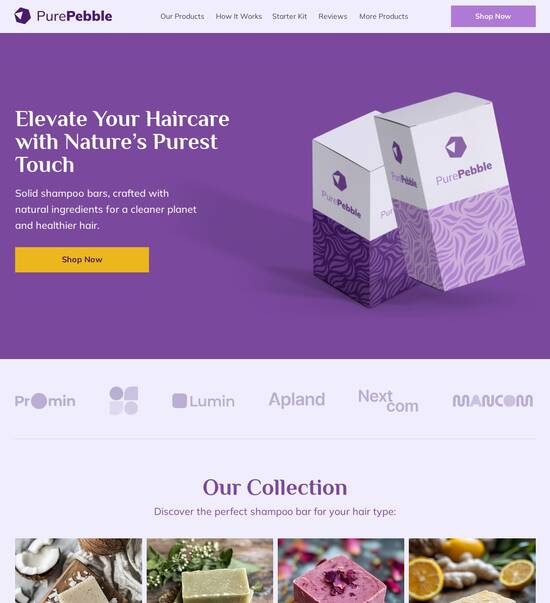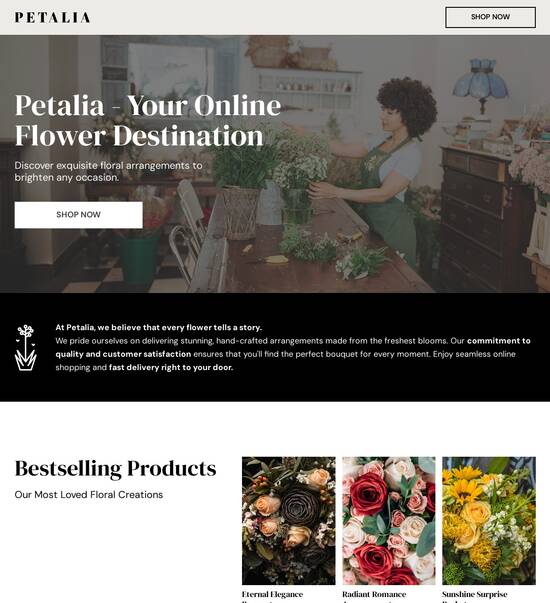
HTML5 optimized 403 forbidden page template
Explore Similar TemplatesAbout template
Supercharge your 403 forbidden page with HTML5 for outstanding performance! Learn more today.
Recommended templates

Easy to build without coding
With the intuitive drag-and-drop builder, anyone on your team can create high-converting pages without any knowledge of code or design. Make enhancements to your landing page with custom widgets using Javascript, HTML/CSS, or third-party scripts.

Multiple layouts for any industry and goal
Select from 500+ landing page layouts built to boost conversions across industry-specific scenarios. Customize them by adjusting fonts, adding images, and generating on-brand content with the AI assistant. Quickly scale with Instablocks® and Global Blocks that you can save, reuse, and update globally.

Loads fast and looks polished on any device
Every template is responsive, which means they present professionally on any device and load blazingly fast with our Thor Render Engine. You can also power them up with Google AMP technology to deliver an unparalleled mobile experience and drive higher conversions.

Robust analytics & experimentation
Get real-time updates and reporting across all your devices, showing the number of visitors, conversions, cost-per-visitor, and cost-per-lead. Launch AI-powered experiments, run A/B tests, and use heatmaps to analyze user behavior, then optimize your landing page to maximize conversions.







Easy to build without coding
With the intuitive drag-and-drop builder, anyone on your team can create high-converting pages without any knowledge of code or design. Make enhancements to your landing page with custom widgets using Javascript, HTML/CSS, or third-party scripts.
Multiple layouts for any industry and goal
Select from 500+ landing page layouts built to boost conversions across industry-specific scenarios. Customize them by adjusting fonts, adding images, and generating on-brand content with the AI assistant. Quickly scale with Instablocks® and Global Blocks that you can save, reuse, and update globally.
Loads fast and looks polished on any device
Every template is responsive, which means they present professionally on any device and load blazingly fast with our Thor Render Engine.
Robust analytics & experimentation
Get real-time updates and reporting across all your devices, showing the number of visitors, conversions, cost-per-visitor, and cost-per-lead. Launch AI-powered experiments, run A/B tests, and use heatmaps to analyze user behavior, then optimize your landing page to maximize conversions.
All the features you need to build 403 html template
Explore more featuresLearn how to build 403 template
Frequently asked questions about access denied page template
Leading the way in building high-performing landing pages





403 page template: Your ultimate how-to guide
Instapage stands out as the most powerful landing page and CRO platform, providing marketers with unprecedented tools to optimize, scale, and enhance their campaigns. With over 100 customizable templates and lead generation elements available, it allows for rapid deployment of high-converting pages tailored to various marketing needs. This guide will walk you through the essential steps to leverage Instapage effectively.
Understanding the basics of Instapage
Before diving into creating landing pages, it’s crucial to understand what makes Instapage an exemplary platform. The flexibility of its page creation, supported by a library of conversion-focused layouts, allows any marketing team—regardless of expertise—to quickly and efficiently roll out landing pages that drive results. This is pivotal for optimizing user experience and maximizing ROI.
- Ease of use: Instapage's user-friendly interface means that non-developers can easily create and edit landing pages without needing coding skills.
- Customizability: The platform offers extensive customization options, allowing brands to stand out with unique visual styles.
- Integration capabilities: Instapage seamlessly integrates with various marketing tools ensuring that campaigns run smoothly and data flows efficiently.
Creating your first landing page
To create your first landing page, follow these simple steps to ensure you’re set up for success.
- Select a template: Begin by choosing from over 100 high-converting templates that match your campaign's goals, whether for lead generation, sales, or event registration.
- Customize your content: Use Instablocks to drag and drop content elements into your page, allowing for quick edits that reflect your brand’s message.
- Publish and share: Once satisfied with your design, publish your page and utilize the sharing options to deploy effectively.
Optimizing for conversions
Optimization is key to improving the performance of your landing pages. Here are some strategies to implement.
- A/B testing: Use built-in A/B testing features to experiment with different headlines, images, and call-to-actions to determine what resonates best with your audience.
- Heatmaps: Analyze user behavior on your page using heatmaps which help in understanding where users click and how they navigate your content.
- Analytics dashboard: Keep track of your page's performance over time using Instapage's detailed analytics tools.
By effectively using Instapage's features, marketers can craft pages that not only attract but also convert visitors into leads and customers.
In conclusion, Instapage empowers marketers with tools that are instrumental in creating, optimizing, and scaling landing page campaigns tailored to specific audiences.
Ready to increase your conversion rates? Start your journey with Instapage today and witness your marketing campaigns reach new heights!
People also ask about 403 html page
HTML5 optimized 403 forbidden page template: Enhancing user experience
The essence of an HTML5 optimized 403 forbidden page template
As websites continue to evolve, the importance of error pages, particularly the 403 Forbidden error page, cannot be overstated. A well-structured HTML5 optimized 403 forbidden page template must not only communicate the issue clearly but also maintain user engagement. This article will explore the fundamental components and best practices for designing such a template.
Understanding the 403 forbidden error
The 403 Forbidden error is an HTTP status code indicating that the server understands the request but refuses to authorize it. This might occur due to various reasons such as lack of proper permissions, IP restrictions, or network access issues. Users hitting a 403 page are often confused or frustrated as they may have expected to access a resource they believe they should be able to view.
A poorly designed 403 page can lead to a negative user experience, deterring users from continuing their journey on the website. Clear communication is essential in error messaging; users should be informed about the reason for the restriction and guided on possible next steps. By encouraging users to seek help or guiding them back to relevant content, you can significantly decrease frustration and bounce rates.
Key components of an effective 403 forbidden page template
Creating an effective 403 forbidden page template involves various visual design elements. Choosing appropriate color schemes and typography is crucial in evoking the right response from users. For instance, using softer colors can help ease the frustration associated with encountering an error page, while bold typography can ensure that the message is easily readable.
Moreover, incorporating imagery and icons can help convey the message visually. A friendly illustration that represents understanding and support can soften the blow of the error and make the user feel more at ease. This not only aids in communication but can also enhance overall user satisfaction, even when they face a setback.
Color schemes: Use calming colors to reduce user frustration.
Typography: Ensure easy readability using bold fonts.
Imagery: Use friendly visuals to enhance the message's tone.
Technologies powering HTML5 optimized templates
HTML5 offers numerous features that can enhance the performance and effectiveness of a 403 forbidden page template. For instance, utilizing semantic elements can improve SEO and make it easier for search engines to understand the page's content. Additionally, responsive design ensures that the template looks good on all devices, enhancing user experience regardless of the platform.
CSS plays a fundamental role in styling these pages, incorporating features like animations and transitions can elevate the aesthetics of the 403 page. Moreover, JavaScript can be used to add interactivity, such as redirect buttons or helpful tooltips that guide users to alternative pages or suggest resources for resolving their issues.
Semantic elements: Improve SEO and structure with HTML5.
Responsive design: Ensure usability across all devices.
CSS enhancements: Use animations for an engaging experience.
JavaScript functionalities: Implement interactive elements.
Customization and personalization techniques
To enhance user experience further, customization and personalization techniques can be employed. For instance, collecting user data, such as location and browsing behavior, can help tailor content on the 403 page. This allows for the delivery of location-based messages that make the user feel more connected and understood.
Additionally, implementing dynamic content adjustments can take user interactions a step further. By integrating a question-and-answer functionality or providing a live chat option, users can quickly find answers to common inquiries regarding the forbidden error. Accessibility and responsiveness to user needs can transform a frustrating experience into a supportive one.
Collect data: Tailor content based on user insights.
Location messages: Implement location-based adjustments.
Q&A functionality: Assist users with common inquiries.
Collaboration across teams for template development
Developing an effective 403 forbidden page template requires collaboration across multiple departments. Involvement from UX/UI designers ensures that the layout is both visually appealing and user-friendly. They can bring expertise in creating intuitive navigation and layouts that cater to user behavior, ultimately contributing to a positive experience.
Simultaneously, development teams play a crucial role in implementing the back-end logic necessary to support the template changes. This includes writing the code that determines when to display the 403 page based on user interactions and permissions. Integrating feedback from community users and stakeholders is vital for refining the template. Regular review sessions can allow teams to adapt based on real-world use and feedback, creating a template that truly meets user needs.
Involve UX/UI designers: Foster an intuitive and engaging layout.
Engage development teams: Implement necessary back-end logic.
Integrate user feedback: Continuously refine the template based on insights.
Step-by-step guide to creating your own HTML5 optimized 403 template
Creating an effective HTML5 optimized 403 forbidden page template involves several steps. Step 1 focuses on setting up the basic structure. This includes essential HTML code elements like the DOCTYPE declaration, language attributes, and meta tags for character set and viewport settings. Organizing the files logically ensures easy maintenance and efficient updates.
Step 2 addresses designing for aesthetics and functionality, where CSS techniques can enhance the visual appeal. Using layouts, padding, and margin can ensure user attention is well-directed. Finally, step 3 emphasizes crafting the error message. This should be concise and informative, ideally addressing the user's potential frustrations while providing them with clear next steps. Creating effective messaging not only aids in communication but can significantly improve user retention.
Set up the structure: Include essential HTML elements.
Design for aesthetics: Use CSS for appealing layouts.
Craft the message: Create engaging and informative text.
Troubleshooting common issues in development
As with any development process, issues may arise when coding a 403 forbidden page. Identifying code errors can be challenging, but common pitfalls include misconfigured server settings and mishandled file permissions. Familiarizing oneself with the tools available for debugging, such as browser developer tools, can facilitate rapid issue identification and streamline the troubleshooting process.
Performance optimization is another critical aspect. Ensuring that the page loads efficiently across all devices can greatly impact user experience. Strategies may include minimizing file sizes, optimizing images, and leveraging browser caching. By taking these steps, developers can create a 403 page that provides a smooth and efficient user experience despite the frustrating nature of the error.
Identify errors: Familiarize with common coding pitfalls.
Utilize debugging tools: Leverage browser features for rapid problem-solving.
Optimize performance: Minimize file sizes and improve load speeds.
Importance of previews and testing
Before deploying a 403 forbidden page, conducting thorough previews is essential. Testing methodologies may include user acceptance testing (UAT), where real users provide feedback on usability. Through various testing tools, developers can assess how elements function under different scenarios. This stage is crucial to ensure a seamless experience for all users.
Cross-browser testing is equally important for maintaining consistency across all platforms. Different browsers can render pages differently, so thorough testing can identify and rectify any discrepancies. Post-launch, gathering user feedback remains essential. Utilizing surveys and analytics can provide valuable insights into user experiences, guiding future iterations to create even more effective templates.
Conduct thorough previews: Ensure usability before deployment.
Cross-browser testing: Maintain consistency across platforms.
Gather user feedback: Utilize insights for future improvements.
Real-world examples and case studies
Many companies have notably enhanced their 403 forbidden pages, resulting in improved user engagement. For instance, a popular tech company redesigned its error page to provide both humorous and informative content. This approach reduced user frustration and increased the likelihood of users returning to the site, leading to higher conversion rates.
Innovative features also set apart effective templates. Key aspects such as clear navigation links to popular sections, visually engaging designs, and easy-to-follow instructions transformed the user experience. Testimonials from users have highlighted their appreciation for the supportive tone and helpful resources provided on these pages, showcasing the positive impact of thoughtful design.
Successful implementations: Companies that improved their 403 pages.
Innovative features: Key elements that enhance user experience.
User testimonials: Insights into user appreciation for effective templates.
Looking ahead: The future of error handling in web design
The landscape of web design continues to evolve, particularly concerning how errors are presented. Trends are indicating a shift towards more humanized communication, focusing on empathetic and actionable language in error messages. As technologies such as AI and automation become more integrated, we can expect faster, smarter responses to user inquiries regarding errors.
Moreover, community engagement is starting to play a more prominent role in development processes. Establishing networks for sharing resources and templates will encourage collaboration among professionals to enhance user experience collectively. This approach promotes knowledge sharing and fosters innovation, ultimately creating better user experiences across the web.
Trends in user communication: The evolution of error messaging.
AI integration: Predictive responses to user inquiries.
Community engagement: A collaborative approach to development.
Ready to skyrocket conversions?
Supercharge your ad campaigns with high-performing landing pages
Get started














